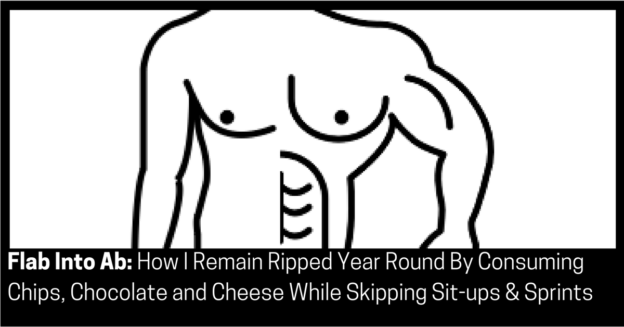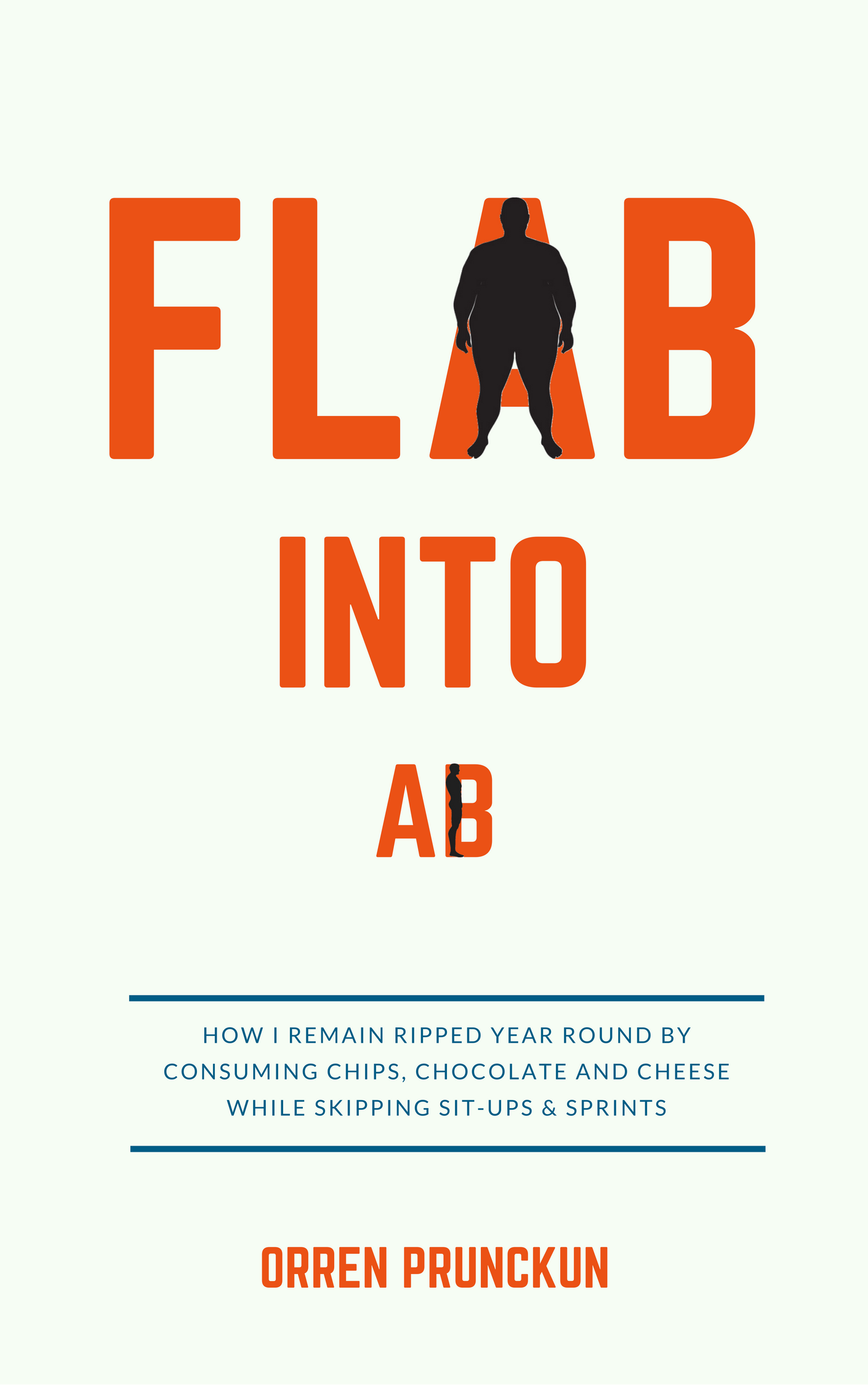Caution: This guide is for informational purposes only. As each individual situation is unique, you should use proper discretion, in consultation with a health care practitioner, before undertaking any diet, exercise and techniques I talk about. You should not use this guide if you have any known medical condition, and you should always consult your health practitioner before beginning any exercise or nutrition program. This guide is not suitable for children under the age of 18 years or pregnant women. These statements have not been evaluated by a medical practitioner. This guide is not intended to diagnose, treat, cure or prevent any disease. If there is a change in your medical condition, you should notify your physician immediately. I expressly disclaim responsibility for any adverse effects that may result from the information I talk about – I’m not a medical practitioner, personal trainer or qualified in anyway, and what follows come from my observations of my experience only. Consult with your doctor if these are right for you. You understand this to be an expression of opinions and not professional advice. You are solely responsible for the use of any content and you hold me and any of my agents harmless in any event or claim.
- PART 1: Why This Guide Is Important To You;
- PART 2: What This Guide Is Really About;
- PART 3: Step-By-Step Way To Get Abs; and
- PART 4: How To Take Action With Your Fitness.
PART 1: Why This Guide Is Important To You
You are still stuck.
I know your story.
Sure, everyone’s situation is different, but the results are usually the same…
I’ve got a quick question for you:
“Do you want your abs to be ripped all year round?”
Come on, you know you want to look like an Abercrombie and Finch underwear model where you are also super strong.
So why hasn’t it happened for you yet?
Come on, admit it – this isn’t the first time you have been looking for that Hollywood Fight Club look, is it?
When is it your turn?
Well, you are going to discover and I’m going to show you how you get and stay super lean and muscular by consuming chips and chocolate and cheese while skipping sit-ups and sprints…
“Hey twiggy, why don’t you eat some food.”
If you knew how much food I ate when I was a kid, you’d think this type of bully comment was preposterous.
Yes, I was rake thin and yes, I ate a lot of food.
I never could put on weight and be at a healthy Body Mass Index (BMI).
For much of my life I had been around 67 kilograms (kg) and about 11% body fat (bf).
A classic skinny/fat ectomorph, both skinny and fat at the same time.
A hard gainer.
Fast metabolism and a small frame.
And ever since I can remember I have been lanky.
I even recall one time in grade 4: At recess I was so hungry that I got a stomach-ache so bad I could hardly stand up (bear in mind I had already eaten a big breakfast that day.)
Fast-forward many years and I was in Las Vegas for a work conference in 2014.
The entourage went to the hotel pool.
I took of my shirt to go swimming and realised how much I didn’t like the way I looked.
Lanky is synonymous with not being very athletic.
The thing is, I’ve played ice hockey for the last 25 years and wanted to be stronger, faster with a lot more stamina, especially as I’ve got “older.”
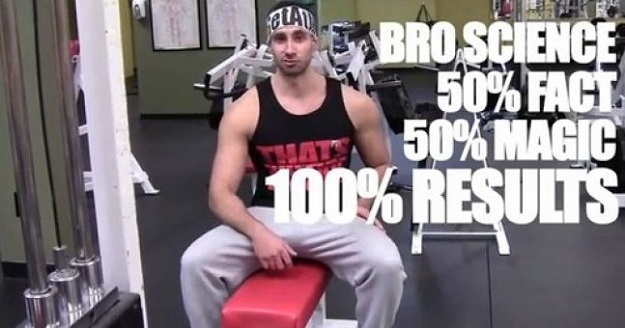
A few years ago I was probably just like you…
I’m sure you have heard of “bro science”?
Bro science is fitness knowledge passed off as fact with little or no real world first-person experience to substantiate conclusions.
Bro science, spread by “bros” in the gym.
Here is some typical bro science that you may think that you need to do:
- Consume a meal every three hours on the dot;
- Consume a meal before you exercise;
- Consume a meal within an hour of your workout;
- Consume six meals a day;
- Consume a protein shake after workouts;
- Consume a “clean” diet of chicken and broccoli;
- Consume a calories surplus;
- Exercise six days a week;
- Etc. Ad nausea.
I have a confession to make…
The problem I had was I used to believe in it.
Maybe you do still?
Well, I tried all the typical bro science.
At the end of 2015, I was 80kg on the dot at about 15% body fat.
In other words, I went from border-line under-weight to border-line over-weight on the BMI index.
But the difference comes from just over 10kg in weigh change.
And for visuals that’s 20 packets of mince beef from the supermarket.
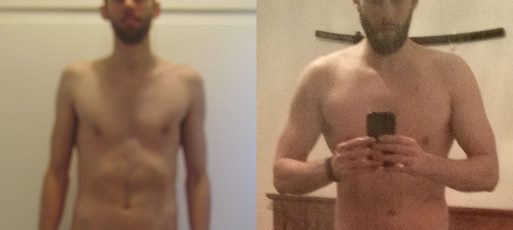
Sure, I put on weight, but I gained body fat as well as muscle.
The bro science approach didn’t really work all that well.
In my experience, bro science is mostly nonsense, especially for having abs ripped all year round.
And that’s when I got a big “Ah Ha” moment.
The real problem is that it’s not based on much science at all.
I decided to try something different: to go turn flab into ab – increasing muscle mass, burn fat by consuming chips, chocolate and cheese while skipping sit-ups and sprints.
On New Year’s Eve 2015, I decided to ignore common fitness “wisdom” and try some new things.
So, I read as much as I could from scientific journals to put the pieces together.
And guess what?
This time it worked!
That’s when I realised the reasons why I hadn’t been successful before.
I discovered the “big lie” and realised that the lack of results before certainly wasn’t my fault and it’s not your fault either.
The real problem for me was a case of “blind leading the blind.”
Or “bros” leading the “bros.”
No wonder I was struggling!
My guess is that this is also what is keeping you from having abs ripped all year round.
So what was the lesson for me out of this?
Just because I assume something is true, doesn’t actually make it true. So test assumptions – not just in fitness but everything in life…
As Venture Capitalist Marc Andreessen said, have “strong opinions, loosely held.”
But don’t think that you can do it on own.
I’ll show you how I did it.
You can look over my shoulder, so to speak. It’s hard to believe, but I’ll show you how easy it is.
Let’s go over it – here is what I do:
- Consume all my calories in a five to eight hour window each day;
- Consume meals when I’m hungry;
- Consume only one to two meals a day;
- Consume no liquid meals (protein shakes are out);
- Consume a moderate amount of junk food;
- Consume a calorie deficit;
- Consume no food before exercise; and
- Exercise two days a week.
I.e. the opposite of “bro science.”
I also don’t consume a low fat or low carbohydrate diet – your body needs body fats and carbohydrates as these two macronutrients affect certain critical hormones.
Yes, I ate chips, chocolate and cheese each day as long as I followed those rules.
Does it work?
Here is what happened to my measurements when I dropped all the bro science nonsense:
- Body Mass: down 14kg (8kg of those in the first three months);
- Body Fat: down 6.53%
- Waist: down 12cm;
- Bench Press: up 20kg;
- Push Press: up 28.5kg;
- Weighted Pull ups: up 9.5kg; and
- Deadlift: up 42.5kg.
Obviously, after six months, my measurements were going in the right directions…
Body mass and waist went down and all my lifts went up.
I feel like a warrior at ice hockey now – faster & stronger than ever.
In fact, my absolute strength is the best it has ever been and by default, my relative strength is also the highest it has ever been.
But pictures tell 1,000 words, right?!
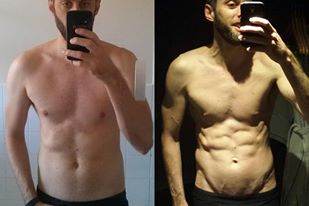
Look at those ab veins!
I distinctly recall six individual people commenting on my progress without any prompts from me (by the way, these comments actually sound ridiculous to me given how hard this journey had been previously.)
I didn’t realise when I started that, not only does this style of fitness produce incredible strength and a great aesthetic, but I also experienced the following:
- Increase in concentration;
- Increase in energy;
- Increase in positive mood;
- Increase in testosterone; and
- Increase in confidence.
Science has also found that this style of fitness is correlated to the following:
- Increase in life expectancy of between 20-30%;
- Increase in insulin sensitivity;
- Decrease in cancer risk;
- Decrease in diabetes risk;
- Decrease in heart disease risk;
- Decrease in obesity;
- Decrease in blood sugar levels;
- Decrease in blood pressure; and
- Many, many more…
[fancy_box id=4]
I have distilled everything I know into a formulaic system and decided to create a fitness guide called Flab Into Ab that is going to show you the fastest and easiest way to get getting and stay lean and muscular even while eating cheese, chips and chocolate each day.
If you have been struggling with making progress with your fitness, then you need this fitness guide!
Just click this link to find out more
If you don’t absolutely love it, I’ll give you your money back and you can keep it anyway.
[/fancy_box]
PART 2: What This Guide Is Really About
I want to outline a justification for this type of training.
Most people looking to get strong…
They want to gain body weight, in other words “be huge.”
However, being huge is not the best differentiator in terms of looks.
Here’s why I follow a “cutting” protocol, that is staying with low body fat and not being huge in terms of body weight.
In my experience, abdominals start to become visible at about 8% body fat or less.
That’s what I aim for.
Everyone thinks they need to gain body weight to look good.
Look at my photos at the start of the guide.
I’m ripped.
I look good.
If I were 70kg with 10% body fat, for simplicity (I’m currently about 8% body fat,) this equates to 7kg body fat and 63kg lean mass.
For me to gain 10kg of lean mass (i.e. pure muscle and staying ripped all year round, not going through cycles of “dirty” gain and cut) and stay at 8% body fat, it would take me several years to do.
I’d look incredible at the end at 80kg.
However, if I were 80kg with 20% body fat (i.e. “huge”), I would have 16kg body fat and 64kg lean mass.
It’s far easier and quicker to drop to 10% body fat than to drop to 10% body fat AND also add 10kg muscle.
I’d still look incredible at the end at 72kg – almost the same regarding proportions as the 80kg comparison.
The latter is what this guide is about – great proportions, just a smaller size.
Let me put it another way.
It’s not the size that matters; it’s the proportions that matter, particularly your shoulders to waist ratio.
Even if I had no muscle and was “skinny/fat,”
I’d still prefer to drop body fat first, to be ripped rather than gain body weight; that way I would look good as quickly as possible and look good while I was in the process of gaining muscle mass later
As Illustrated by the image, the amount of muscles mass is approximately the same, the only difference being the body fat.
Which would you rather be, bulky or cut?
Hopefully, this photograph and explanation changes your view on “being huge” as your only modus operandi.
For most people, including myself, this guide gives two simple options:
- Lose body fat first, then gain muscle mass; or
- Re-compose your body fat and muscle mass at the same time.
It all starts with losing body fat.
“Spot reduction” doesn’t work.
Losing body fat is easy, but takes some patience.
Gaining muscle is harder and takes even more patience.
To have low body fat and high muscle at the same time, you must lose body fat and gain muscle.
This sounds pretty obvious, right?
Well, conventional fitness wisdom is a little off on this, hence why you are here.
Body weight is made up of body fat, bones, cartilage, ligaments, tendons, internal organs, muscle, water, glycogen and so on.
You can manipulate body weight by adjusting any one of those.
Adjusting body fat and muscle is harder to do and is only noticeable over the long term.
Adjusting water and glycogen amounts is easier to do and is noticeable in the short term.
More permanent manipulable weight is muscle and body fat, not water and glycogen.
Manipulating permanent weight has to do with energy.
A calorie is a unit of measure for energy.
Excess calories consumed is excess energy and this is stored as body fat.
Body fat is just excess energy (calories consumed and unburned.)
Thermodynamics is the science of energy.
To lose weight (this could be a combination of body fat and/or muscle), you must burn more calories than you consume.
To lose weight more permanently, you need to consume fewer calories (not to be confused with volume of food) than you burn (how much you burn is based on metabolism, age, thermic effect of food and so on.)
In other words, be in a calorie deficit and you’ll lose body weight.
This is what is referred to as the calories in/calories out model.
However there is a limit to lost: essential body fat – about 3% – is necessary to keep your body alive.
You can’t escape the science of thermodynamics, but there are some ways to cheat it:
- Consume caffeine (such as black coffee) which increases metabolism and speeds up food passing through your digestive system; and
- Expose yourself to the cold which increases metabolism.
Practically, there are three ways to lose body weight:
- Consume a calorie deficit;
- Burn excess calories consumed; and
- A combination of one and two.
All have different effort levels.
Number one is easiest and number three is the quickest.
We don’t just want to lose weight (which is a combination of body fat and muscle), we want to lose body fat only, not muscle! Here is how:
- Eat enough protein;
- Do resistance training; and
- Be in a calorie deficit.
Eating enough protein is needed to feed muscle growth caused by resistance training.
Resistance training with progressive overload (an increase in weight) over time is needed to simulate muscle growth and nutrition partitioning to burn body fat: your body knows muscle is valuable for survival and should be preserved, so energy has to come from body fat not muscle when you are in calorie deficit.
Calorie deficit in this guide follows a calorie restriction protocol.
Calorie restriction is defined as the reduction of calories without incurring malnutrition or a reduction in essential nutrients.
Calorie restriction is the quantity of calories (not volume of food consumed.) Science has unquestionably shown that the following 10 rules are true for losing body fat:
- Eat less calories than you burn;
- Eat less calories than you burn;
- Eat less calories than you burn;
- Eat less calories than you burn;
- Eat less calories than you burn;
- Eat less calories than you burn;
- Eat less calories than you burn;
- Eat less calories than you burn;
- Eat less calories than you burn; and
- Eat less calories than you burn.
It’s worth repeating that many times!
“But that is hard, Orren,” I hear you say.
Yes, it is.
No one likes diets.
And it’s even harder, if you also want to consume chips, chocolate and cheese.
And you get even more cravings for those foods when you eat less calories than you burn.
Even harder is if you eat three standard meals a day.
Or worse, if you eat six meals a day like bro science suggests.
Now, let’s assume that the average person’s maintenance calorie intake is 2,200 (approximately) calories per 24 hours.
If they want to lose more permanent weight (body fat or (unwanted) muscle), they need to eat 2,199 (approximately) or less calories every 24 hours.
We know that to lose weight, they need to be in a calorie deficit – enough to lose weight but enough not to make life miserable (I’ve done 500 calories a day on a 5:2 fasting regime and that was tough) so that means they should consume about 2,000 (approximately) calories per 24 hours.
2,000 calories in 24 hours divided by three meals is 666 calories per meal.
This image shows a 690 calorie meal:
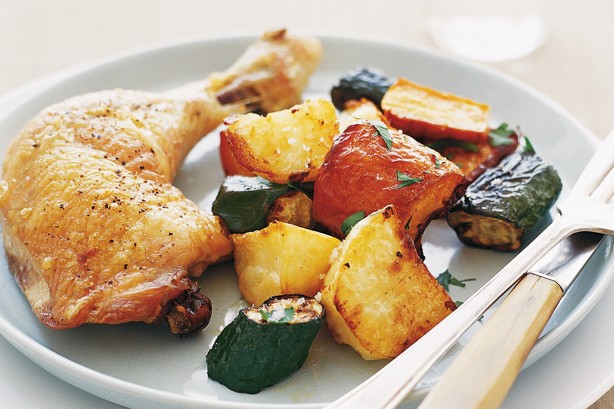
That’s not much food.
As you can guess, it’s really easy to eat over that amount!
666 is the devil’s number, by the way.
And eating like this is hell!
Any more calories than that and they gain body fat (assuming no resistance training or other exercise.)
Any less calories than that and he loses body fat (again, assuming no resistance training or other exercise.)
Remember body fat is only stored excess calories.
The “normal” western eating cycle is three meals a day.
Three meals eaten per day over a typical day is an eating window of 14 hours (6.30am, 1pm and 8.30pm for breakfast, lunch and dinner respectively.)
But, what if you dropped one meal and only ate twice a day but the same calories?
2,000 divided by two meals is 1,000 calories per meal.
A 1,100 calorie meal is illustrated in this image:
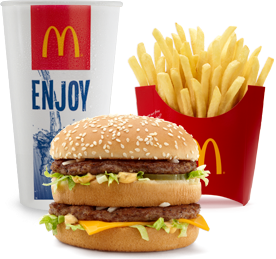
Delicious!
And it’s getting a lot harder to over-eat the amount of calories of this food!
Especially if you reduce your eating window to between 1pm and 8.30pm for the two meals.
Now, what if you dropped two meals and only ate once a day with the same calories?
2,000 divided by one meal is 2,000 calories per meal.
You could eat four Big Macs or two Big Mac Extra Value meals and still be on target!
Delicious!
And it’s getting even more difficult to over-eat your calories with this food!
Especially if you reduce the eating window to one hour at 8.30pm for the one meal.
Same calories but now you’re feasting like a king. This is called fasting or nutrient frequency.
Fasting or nutrient frequency is the regularity of food consumed.
It is the act of not eating for a period of time and it may be intermittent in nature.
Intermittent fasting is an umbrella term for a cycle between a period of fasting and non-fasting, or feast and famine.
Intermittent fasting can be used in conjunction with calorie restriction.
Time-restricted feeding is a specific type of intermittent fasting.
In this guide, I will be using the Fast 5 variation.
Fast meaning fasting.
Five meaning a five-hour eating window, which is also fast – no pun intended.
Other versions of intermittent fasting include:
- Alternate day fasting which involves a 24-hour fast followed by a 24-hour non-fasting period; and
- Alternate day calorie restriction which involves eating 500 calories for two days a week and “regular” calories for the rest.
“Regular” calories mentioned in Alternate day calorie restriction can be problematic as the word regular is subjective and the amount of calories could vary wildly.
Regular should be interpreted as maintenance calories.
None of these variations of fasting breakdown muscle mass.
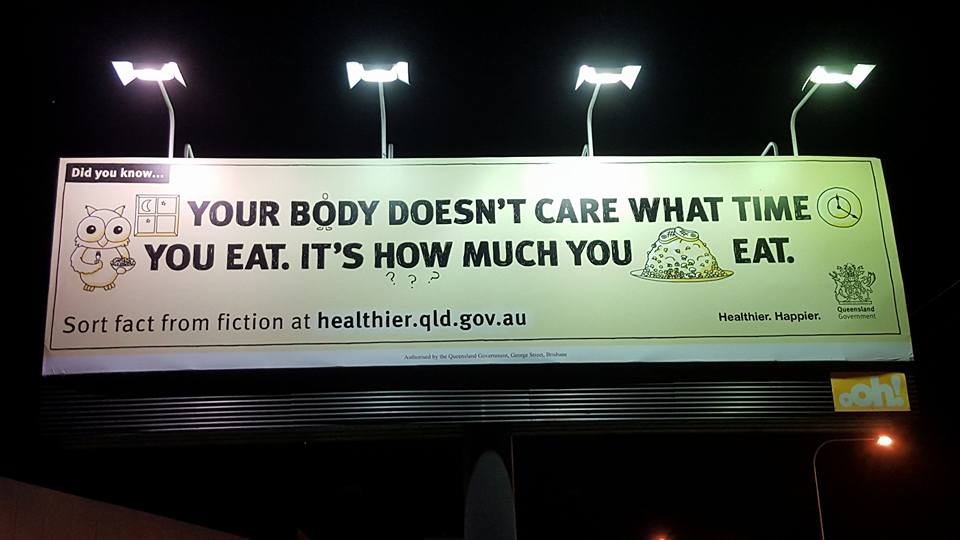
Related to fasting is nutrient timing – the time when you consume food.
This is important because the time when your body receives calories does not affect your body composition all that much, as illustrated by the Queensland Government advertising campaign.
If it is good enough for them, it is good enough for me!
Nutrient timing is the window of time in which you eat your food.
You can eat whenever you want – morning or night and even right before bed – as long as you are consistent with your nutrient frequency and timing.
Besides bro science, one of the main reasons I wasn’t getting success, even after I knew what to do, was, in truth, that I had been inconsistent.
[fancy_box id=4]
I have distilled everything I know into a formulaic system and decided to create a fitness guide called Flab Into Ab that is going to show you the fastest and easiest way to get getting and stay lean and muscular even while eating cheese, chips and chocolate each day.
If you have been struggling with making progress with your fitness, then you need this fitness guide!
Just click this link to find out more
If you don’t absolutely love it, I’ll give you your money back and you can keep it anyway.
[/fancy_box]
PART 3: Step-By-Step Way To Get Abs
Turning flab into ab and getting abs is a matter of following six steps. Here they are:
- STEP 1: Daily Preferences;
- STEP 2: Setting Course;
- STEP 3: Exercise (including resistance training);
- STEP 4: Nutrition (including calories, macronutrients, nutrient timing, micronutrients and supplements);
- STEP 5: Recovery; and
- STEP 6: Repeat (including consistency).
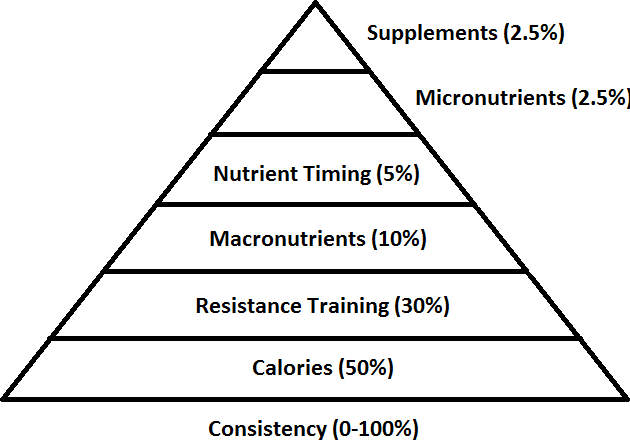
Before we get into the steps, it’s important to understand the “body composition priority pyramid.”
Here are the inputs, in addition to consistency, that you need to help you succeed:
- Calories (energy);
- Resistance training;
- Macronutrients (particularly protein);
- Nutrient timing and nutrient frequency;
- Micronutrients; and
- Supplements.
These inputs are listed in priority order and in order of magnitude to illustrate their potential impact on body composition.
There are some important preferences related to fitness, which you need to choose before you move on to the rest of this guide, to help you be successful.
The most important fitness preferences (in no particular order) for this guide are as follows:
- Quantity of Food;
- Window of Eating;
- Exercise Frequency;
- Time of Exercising;
- Time of Eating; and
- Time of Sleeping.
Choosing your preference for each of these will set the foundation of your daily routine that the rest of this guide is based on.
As previously discussed, consistency with these daily preferences (also known as a “daily routine”) is the most valuable input that will determine the success you have.
For the full details on this click here.
You will track nutrition measurements to determine if you are losing body fat.
If you are losing body fat, this means that you are increasing your relative strength and getting stronger.
The main nutrition measurement you will track is calorie intake per day.
You have three possible courses of action which will determine your nutrition. You can:
- (Lean) gain;
- Maintain; or
- Cut.
If your body fat percentage is 8% or less, then you should maintain or gain body weight (in a lean way).
If your body fat percentage is more than 8%, then you should maintain or cut body weight.
Great physical aesthetics, especially for a non-steroid look, come down to concentrating on body parts in the following priority order:
- Shoulders;
- Core;
- Chest;
- Legs;
- Back; and
- Arms
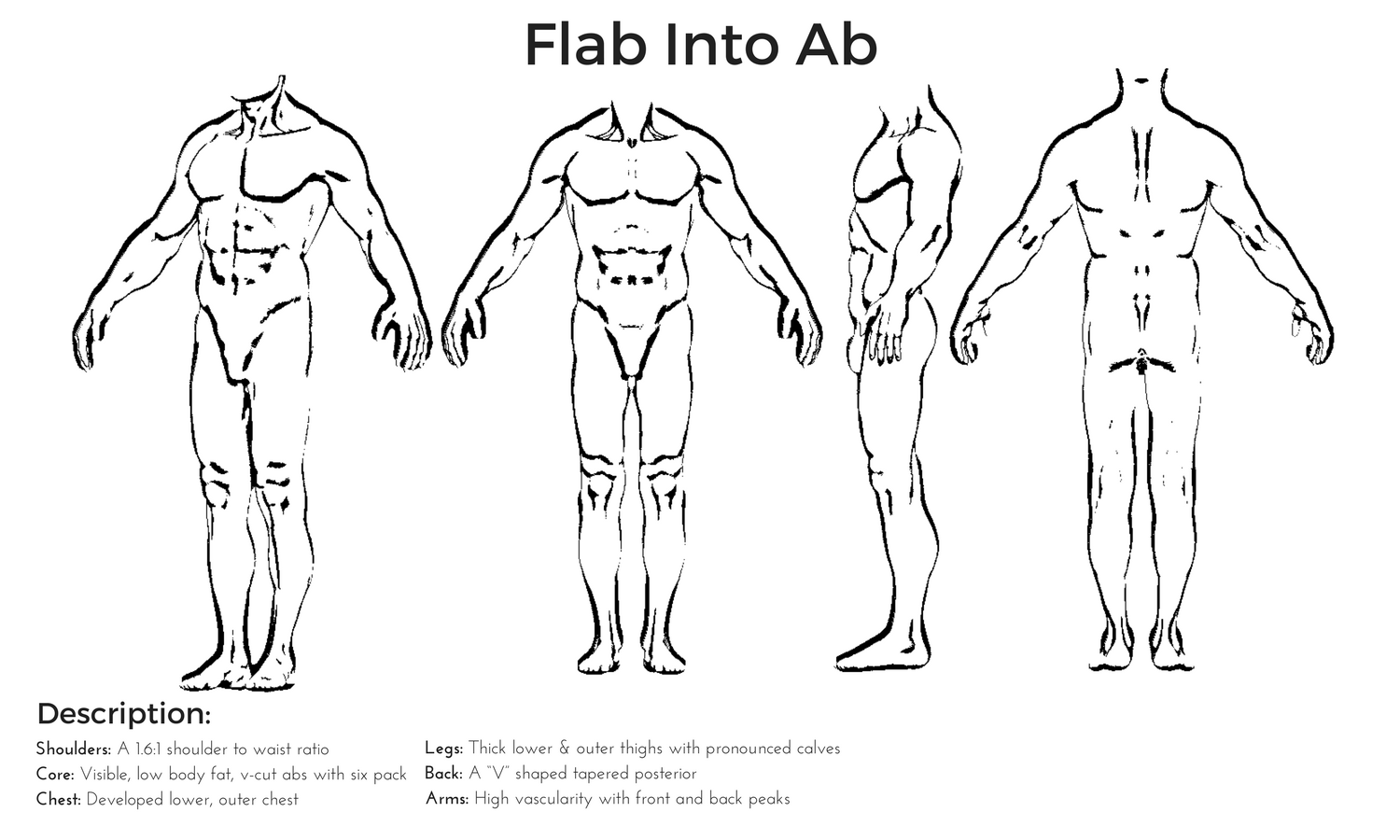
The first three are visible front on, so we’ll concentrate on these.
Each of these body parts should have the following features:
- Shoulders: A 1.6:1 shoulder to waist ratio;
- Core: Visible, low body fat, v-cut abs with six pack;
- Chest: Developed lower, outer chest;
- Legs: Thick lower & outer thighs with pronounced calves;
- Back: A “V” shaped tapered posterior; and
- Arms: High vascularity with front and back peaks.
So let’s explore each of these features in terms of the related muscles you will need to exercise.
Shoulders

Description:
- A 1.62:1 shoulder to waist ratio.
Muscle:
- Deltoids; and
- Trapezius.
Core
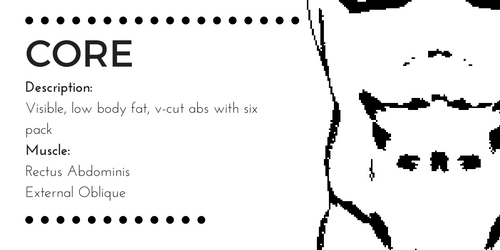
Description:
- Visible, low body fat, v-cut abs with six pack.
Muscle:
- Rectus Abdominis; and
- External Oblique.
Chest
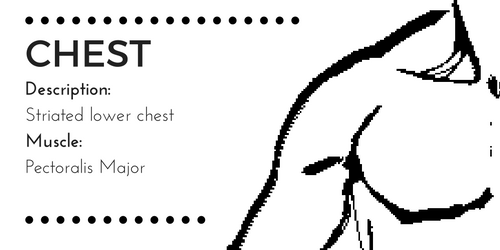
Description:
- Developed lower, outer chest.
Muscle:
- Pectoralis Major.
Legs
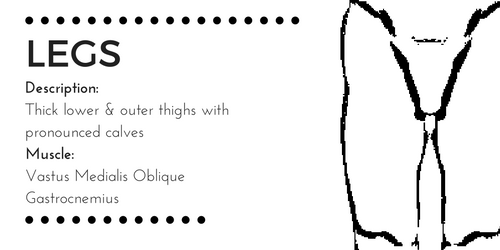
Description:
- Legs: Thick lower & outer thighs with pronounced calves;
Muscle:
- Vastus Medialis Oblique; and
- Gastrocnemius.
Back
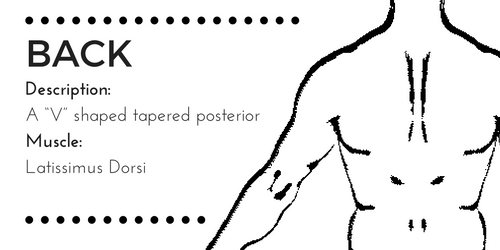
Description:
- A “V” shaped tapered posterior.
Muscle:
- Latissimus Dorsi.
Arms
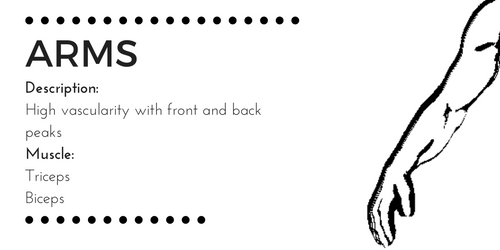
Description:
- High vascularity with front and back peaks.
Muscle:
- Triceps; and
- biceps.
Now that you know the features of each of the body parts and the related muscles to get them, you will need to do resistance training.
For the full details on this click here.
So what should your food be made up of?
You still get to consume chips, chocolate and cheese and lose body fat if you can adopt the following mantra:
IIFYC – if it fits your calories (rather than IIFYM – if it fits your macronutrients.)
It doesn’t matter if you eat “clean” or “dirty” food. Only calories matters.
For illustration purposes, if you eat a calorie surplus of “clean” food, for example vegetables only, you are still in a calorie surplus and will gain weight (this could be a combination of body fat and/or muscle).
Likewise, if you eat a calorie deficit of “dirty” food, for example chocolate only, you are still in a calorie deficit and will lose weight (this could be a combination of body fat and/or muscle).
Case in point – I love chips, chocolate and cheese and I eat some of those daily and I have ripped abs.
I get people saying this is “not healthy.”
Rather than getting into this debate, I want to kill some myths about fitness.
Fitness is one of those terms that is problematic.
It’s hard to define and very subjective.
If you look at the dictionary definition of “fitness” it is “the condition of being physically healthy.”
Again “healthy” is one of those terms that is hard to define and very subjective.
“Healthy” also opens up a massive can of worms in what can be a discussion ranging from science to semantics, subjectivity to commercial propaganda, and cognitive biases to bro science.
If you look at the dictionary definition of “healthy” is “a good physical condition.”
A good physical condition could be – depending on whom you ask such as a doctor, a nutritionist, an average person, a body builder, etc.:
- Body Mass Index;
- Weight;
- Disease level;
- Type of diet;
- Nutrient content;
- Amount of food;
- Amount of exercise;
- Type of exercise;
- Amount of rest;
- Type of rest;
- Body fat composition;
- Strength;
- Etc. Ad nausea.
I am going to be using the words “healthy” and “fitness” in terms of “body fat composition” and “strength,” respectively.
Particularly, the version of these two as being lean and muscular.
Having said all this, eat food where you get macronutrients and micronutrients.
As a rule of thumb, “dirty” foods have:
I am going to be using the words “healthy” and “fitness” in terms of “body fat composition” and “strength,” respectively.
Particularly, the version of these two as being lean and muscular.
Having said all this, eat food where you get macronutrients and micronutrients. As a rule of thumb, “dirty” foods have:
- Small volume (i.e. not filling);
- Low micronutrients; and
- Induce cravings.
“Clean” foods have:
- Large volume (i.e. filling);
- High micronutrients; and
- Do not induce cravings.
Here are foods on the Satiety Index. The Satiety Index measures how full certain foods make you feel. Note: many of them are “unhealthy”.
Very Full:
- Vegetables;
- Fruit;
- Potatoes; and
- Grains.
Full:
- Beans;
- Pasta;
- Rice;
- Chocolate;
- Chips; and
- Cheese,
Empty:
- Ice cream; and
- White bread.
Very Empty:
- Yogurt; and
- Candy bars.
Now that we know the step-by-step method for getting abs, let’s take action.
After completing this guide, you should be able to get and stay super lean and muscular by consuming chips and chocolate and cheese while skipping sit-ups and sprints…
Here are the actions you need to take:
- Set your goals;
- Pick your preferences;
- Track your metrics;
- Workout;
- Eat;
- Recover; and
- Repeat.
You now have a solid plan to get and stay lean and muscular.
That’s all you need to know and it will be more than enough for you to get started on your own.
This maybe the momentum you need to turn flat to ab.
PART 4: How To Take Action With Your Fitness
Okay, what is the point of this section?
Good question…
I want to inspire you to focus on what you want and say no to anything that gets in the way.
Focus. So simple, yet so hard.
Seriously, statistically, you have less than 85 years to live.
And you are probably 1/4+ of the way through that already.
STOP FOOLING AROUND.
Whatever your goal is, it’s totally possible.
Start small, but be consistent.
The latter is far greater than the former.
Will you smash it out of the park?
I’d be lying if I said it was easy – it wasn’t easy at all.
I’ve been where you are and I know how hard it can seem.
I have distilled everything I know into a formulaic system and decided to create a fitness guide called Flab Into Ab that is going to show you the fastest and easiest way to get getting and stay lean and muscular even while eating cheese, chips and chocolate each day.
The creation of the Flab Into Ab guide was particularly hard – from creating the calculations, to creating the sequence, to creating the method.
Not only that, it took me what I estimate to be 10 years of trial and error to find the knowledge needed to put into it.
Now I have it, it makes getting lean and strong so easy.
Yes, I still use the principles in this guide daily, even though I am where I want to be.
What used to take me hours of effort in the gym and the kitchen is reduced.
My old solution was to cobble together a bunch of smartphone software tools such as Evernote and Google Sheets, my phone’s stopwatch, audio player, and camera to get me through. It was much like Frankenstein – it was all over the place, hard to keep track of and just a lot of work documenting, calculating and switching between apps.
No more spreadsheets.
No more calculating.
No more sprawling file folders, etc.
Now, while it would be impossible to show you ALL of the benefits the Flab Into Ab guide, I want to show you some of the things that you’ll get as soon as you’re have it.
Here is what the guide does and how it can help you:
- Tells you to cut or bulk depending on your body fat percentage to look the best in the least possible time and effort;
- Tells you the type of workout you should being doing each day;
- Tells you the variation of workout you should being doing each day;
- Tells you the time of day you should workout;
- Tells you the time of day to eat your first meal;
- Tells you the time of day to start eating your last meal;
- Tells you the weight to lift on each workout day;
- Tells you the number of repetitions to lift on each workout day;
- Tells you the number of sets to lift on each workout day;
- Tells you the time required each workout; and
- Tells you the time of rest required between each set
What all of this means is:
“You never need to do any tedious research again.”
Would you like to get access to this?
I am offering you the Flab Into Ab guide.
The total value of all of this is $67 USD.
Let me ask you some questions…
“If all of these I mentioned helped you get the body you want, would it be worth that price?”
“If all this did was let you drop the kilos, would it be worth it?”
I’m not going to charge you $67 USD.
I’m only going to charge you $39 USD, because I want you to succeed. For the cost of a night out, you can get access to everything inside of the Flab Into Ab guide.
Even at $39 USD, you may be nervous because there are a lot of scam artists out there.
I’m going to put all the risk on me and give you my 100% money back guaranteed, to make sure you are successful and take the leap of faith with me.
If you are not happy for any reason at all, simply email me and I’ll refund you money in full.
But you have to act now, because I’m considering putting the price up to $67.
And when this price is gone, it is GONE.
Just imagine what life will be like when you get the body with abs you want…
So click here right now, and you’ll be taken to a secure order form.
For those of you who are already keen jump into this app head first, get started without delay.
What will happen next, is you will be directed to PayPal to purchase.
After you put in your credit card information, you will be redirected to a secure members’ area where you can access the guide and you can begin the workout and nutritional program straight away.
4 clicks from now will be on way to success.
And for those of you who are sitting on the fence, let me say this – is not about me or my success.
I don’t care if you use this guide or not.
It doesn’t make a difference to my life, but tomorrow you will still be in same situation with the body you are not happy with.
This is about you and your results.
This offer won’t be up forever, I have a lot of other things to do.
You see…it doesn’t matter to me if you sign up right now or not.
I’ll still be going about my daily routine, eating chips, chocolate and cheese, hitting my fitness goals with absolute certainty, whether you join in.
However, without help from this guide, you’ll ALWAYS be working harder than you really need to.
I know it sounds kind of harsh, but I think you’ll agree that it’s true.
Remember, you get access to the Flab Into Ab guide for $39.
Get started today and I’ll see you in the members area.
[/fancy_box]
No Guarantee: I am serious about helping people, however results are not typical. This is because the majority of people don’t take action. Understand that I am half the equation. It’s up to you to follow this guide to get results. Every effort has been made to accurately represent my products. The examples used are exceptional results and don’t apply to the average consumer. They are not intended to represent or guarantee similar results. Individual success depends on a multitude of factors such as dedication, desire and motivation. I believe in hard work, giving value and helping others. I make no guarantees because I don’t know you – your results are up to you.

